Stars and tidal streams
Stellar component
Visualising the density of stars usually does not look very impressive. Another (more complicated) method is to mimick observations by the Hubble Space Telescope, as shown in the pictures of the simulated Milky Way (first two pictures): if the HST could observe our galaxy from far away, it would get a similar picture. Blue dots mark extremely hot and massive stars, red dots resemble old and cold stellar populations.
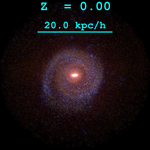 |
Stellar disk of the Milky Way in the Constrained Simulation of the Local Group (WMAP3), as it might be seen from a Hubble Space Telescope at a different galaxy. Face-on. (A. Khalatyan ; PMViewer ) [png, 1024×1024, 1.6 MB] |
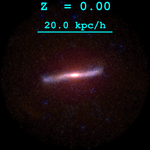 |
Stellar disk of the Milky Way in the Constrained Simulation of the Local Group (WMAP3), as it might be seen from a Hubble Space Telescope at a different galaxy. Edge-on. (A. Khalatyan ; PMViewer ) [png, 1024×1024, 1.6 MB] |
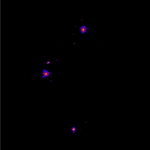 |
Projection of the three main halos (MW, M31, M33) along the z-direction. The shown box has a size of 1.3 Mpc/h per side. (G. Yepes) [png, 1574×1154, 22 KB]Versions with dm and gas distribution are available at: dm [png, 1574×1154, 503 KB] gas [png, 1574×1154, 357 KB] |
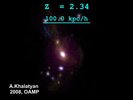 |
Stellar evolution of one of the main galaxies. (A. Khalatyan; PMViewer) |
(Stellar) tidal streams
Tidal streams give evidence to the violent merging history of galaxies: Small dwarf galaxies are encircling their host galaxy and are torn apart by tidal forces. The lost matter forms a leading and trailing stream: ahead of the dwarf galaxy and behind it.
The pictures show that stellar streams are actually forming in cosmological simulations and lie nicely on top of the dark matter stream – just as expected.
Technical details
The pictures were created by Kristin Riebe, using data from the Constrained Simulation of the Local Group (WMAP3) with a resolution of 4096^3 particles. Three host halos were considered: the simulated counterparts to the Milky Way, M31 and M33.
Halos and subhalos were found using the Amiga Halo Finder (AHF, Knollmann&Knebe 2009).
The pictures themselves are generated using IDL.
Each picture shows the projection of the particle distribution to the x-y-plane of the simulation box, particles in low density regions (dark colors) are plotted first and overplotted by particles in high density regions (bright colors).
Tidal stream of satellite #154
Satellite of M33
infall at redshift z = 0.845
total number of particles: 20715
colors: brightness indicates density
grey line = path of the satellite
Please click directly on the image for a larger version.
A movie of the formation of the streams is available at the bottom.
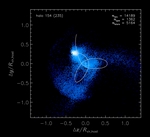 |
dark matter |
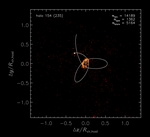 |
gas |
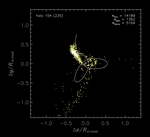 |
stars |
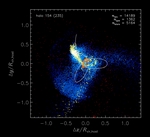 |
all components |
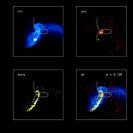 |
Formation of a tidal stream from a satellite galaxy of M33 in the hydrodynamical Local Group (re-)simulation with WMAP3, 40963 particles (K. Riebe; IDL) |




